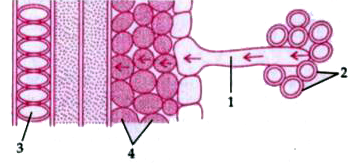[A]: Presence of tail in children is a vestigial character.
[R]: This is due to the phenomenon called atavism
If both A and R are true and R is the correct explanation of A
If both A and R are true but R is not the correct explanation of A
If A is true and R is false
If both A and R are false
The correct Answer is:A
Step-by-Step Solution:
1. Understanding the Assertion (A): The assertion states that the presence of a tail in children is a vestigial character.
- Explanation: A vestigial character is an organ or body part that has lost most or all of its original function through the course of evolution. In humans, examples include the tailbone, wisdom teeth, and the appendix.
2. Defining Vestigial Characters: Vestigial characters are remnants of features that served a purpose in the organism's ancestors but are no longer functional in the current form.
- Examples: In humans, the tailbone is a remnant of a tail that our ancestors had.
3. Understanding the Reason (R): The reason provided states that the presence of a tail in children is due to a phenomenon called atavism.
- Explanation: Atavism refers to the reappearance of traits from an ancestral lineage that have been absent for several generations. This can occur when certain genes that were dormant or suppressed become active again.
4. Connecting A and R: The assertion is that the tail is a vestigial character, while the reason explains that the appearance of a tail in children can be attributed to atavism, which is the re-emergence of ancestral traits.
- Conclusion: Both the assertion and the reason are true, and the reason provides a correct explanation for the assertion.
5. Final Answer: Therefore, the correct conclusion is that both A and R are true, and R is the correct explanation for A.
---
- Explanation: A vestigial character is an organ or body part that has lost most or all of its original function through the course of evolution. In humans, examples include the tailbone, wisdom teeth, and the appendix.
- Examples: In humans, the tailbone is a remnant of a tail that our ancestors had.
- Explanation: Atavism refers to the reappearance of traits from an ancestral lineage that have been absent for several generations. This can occur when certain genes that were dormant or suppressed become active again.
- Conclusion: Both the assertion and the reason are true, and the reason provides a correct explanation for the assertion.
Topper's Solved these Questions
Similar Questions
Knowledge Check
Red colour of tomatoes, carrots and chillies is due to the presence of a type of carotene pigment called as
AluteinBlycopeneCfucoxanthinDphycoerythrin.
Fill in the blanks.
(a) A colloid is a ……… mixture and its components can be separated by the technique known as ……… .
(b) Ice, water and water vapour look different and display different ………. Properties but they are ……. the same.
(c) A mixture of chloroform and water taken in a separating funnel is mixed and left undisturbed for some time. The upper layer in the separating funnel will be of ........ and the lower layer will be that of ....... .
(d) A mixture of two or more miscible liquids, for which the difference in the boiling points is less than 25 K can be separated by the process called .......... .
(e) When light is passed through water containing a few drops of milk, it shows a bluish tinge. This is due to the ...... of light by milk and the phenomenon is called .......... . This indicates that milk is a ........... solution.
View SolutionA : Azotodesmic lichens are biofertilisers enriching nitrogen contents in soil.
R : This ability is due to the presence of heterocystous blue-green algae as phycobiont component.
View SolutionThe figure given below is a diagrammatic representation of a part of the cross section of the root in the root hair zone. Study the same and then answer the questions that follow :

Due to an excess of this pressure sometimes drops of water are found along the leaf margins of some plants especially in the early mornings. What is the phenomenon called ?
View SolutionAssertion (A) : Non-stoichiometric compounds are called Bertholide compounds. NaCl and KCl crystal, when heated in an atmosphere of Na and K varpours, respectively, they impart violet and yellow colours to NaCl and KCl, respectively.
Reason (R ) : Metal excess defect is due to the presence of extra cations atg the interstitial sites. The excess metal ions move to the interstitial sites and the electrons to the neighbouring sites. The colour results byt the excitation of these electrons by absorbing suitable energy from visible light. When the excited electroon comes back to the ground state, there is emission of radiation in the visible region and gives complimentary colour.
View Solution(A) : Self-inductance is called the inertia of electricity.
(R) : Self-inductance is the phenomenon, according to which an opposing induced e.m.f. is produced in a coil as a result of change in current or magnetic flux linked with the coil.
View SolutionAnimals living in colder region have shorter tail and ears as compared to the animals living in warmer regions. This phenomenon is called
View SolutionAnimals living in colder region have shorter tail and ears as compared to the animals living in warmer regions. This phenomenon is called
View Solution
